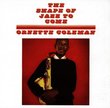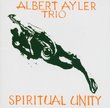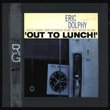| All Artists: Cecil Taylor Title: Unit Structures Members Wishing: 2 Total Copies: 0 Label: Toshiba EMI Japan Release Date: 1/13/2008 Album Type: Original recording remastered, Import Genres: Jazz, Pop Style: Avant Garde & Free Jazz Number of Discs: 1 SwapaCD Credits: 1 |
Search - Cecil Taylor :: Unit Structures
 | Cecil Taylor Unit Structures Genres: Jazz, Pop
Japanese 24bit remastered reissue by RVG. Originally released on Blue Note in 1966. Packaged in a miniature LP sleeve reproduction of the original artwork. |
Larger Image |
CD DetailsSynopsis
Album Description Japanese 24bit remastered reissue by RVG. Originally released on Blue Note in 1966. Packaged in a miniature LP sleeve reproduction of the original artwork. Similar CDs
|
CD ReviewsUnit structures indeed ! nadav haber | jerusalem Israel | 06/23/2007 (5 out of 5 stars) "There should be no misunderstanding - Cecil Taylor meant it when he called this album "Unit Structures". That these structures are experimental in nature does not make them less "structured". By respecting his audience, Taylor is not content with repeating old structures (12, 16, 32 bars). He experiments with different elements of structure - the structure of instrumentation, of the melodic development, of the dynamics. You will notice how on each piece the instrumental structure changes - piano and drums, a bass joins, the drums drop out and a second bass joins, etc. The two takes of "enter evening" prove that the musicians were provided with a basic melodic line which is the starting point and the point of departure for their collective experiments. We should be thankful for artists such as Taylor who respect us enough to attempt to find something new for us, who believe that we deserve a broadening of the musical spectrum. For the edventureous experiments, for the many beautiful moments, and for the communicative energies - this is a definite 5 star album worth having and listening to." Good summation of the free Jazz spirit through piano Jules McCaffery | Boston | 06/01/2007 (4 out of 5 stars) "Although nothing here is as shocking as Albert Ayler's forays into structure/less jazz improvisation--nor as revolutionary as Ornette Coleman's hard-charging free-bop assault; Cecil Taylor introduces a comparatively difficult to manipulate instrument to free jazz; the piano. His fingers sound like they are that of a millipede on some of these tracks because I honestly cannot distinguish notes at times. Instead everything is clustered in spasmic leaps. The great part about this seeming indulgence, however, is that there is a well-studied classicism here. Strings pop up and fade away. Best of all, in true Blue Note fashion, it is a live recording with all of the great explosive energy of 60's freak out jazz. I would recommend this for progressive enthusiasts of any music who are looking for a change from brass-based free jazz, with a touch of classical, or even avant rock tendencies. That is not to say this CD is cosmic. Quite the opposite actually--this is rooted in the hard sounds of jazz and amidst all of its beauty, it is also menacing at times. Solid for sure. I would recommend Ornette Coleman's live at the Golden Circle or any of the Ayler 'Spirit' series if unrestrained energy is what you are looking for. If you prefer the mathematician approach of Thelonious Monk and wonder what he would have attempted if pumped full of endorphins and 60's counterculture; start with Unit Structures."
|

 Track Listings (5) - Disc #1
Track Listings (5) - Disc #1


